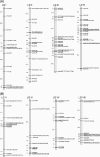Construction of a genetic linkage map based on amplified fragment length polymorphism markers and development of sequence-tagged site markers for marker-assisted selection of the sporeless trait in the oyster mushroom (Pleurotus eryngii)
- PMID: 22210222
- PMCID: PMC3294488
- DOI: 10.1128/AEM.07052-11
Construction of a genetic linkage map based on amplified fragment length polymorphism markers and development of sequence-tagged site markers for marker-assisted selection of the sporeless trait in the oyster mushroom (Pleurotus eryngii)
Abstract
A large number of spores from fruiting bodies can lead to allergic reactions and other problems during the cultivation of edible mushrooms, including Pleurotus eryngii (DC.) Quél. A cultivar harboring a sporulation-deficient (sporeless) mutation would be useful for preventing these problems, but traditional breeding requires extensive time and labor. In this study, using a sporeless P. eryngii strain, we constructed a genetic linkage map to introduce a molecular breeding program like marker-assisted selection. Based on the segregation of 294 amplified fragment length polymorphism markers, two mating type factors, and the sporeless trait, the linkage map consisted of 11 linkage groups with a total length of 837.2 centimorgans (cM). The gene region responsible for the sporeless trait was located in linkage group IX with 32 amplified fragment length polymorphism markers and the B mating type factor. We also identified eight markers closely linked (within 1.2 cM) to the sporeless locus using bulked-segregant analysis-based amplified fragment length polymorphism. One such amplified fragment length polymorphism marker was converted into two sequence-tagged site markers, SD488-I and SD488-II. Using 14 wild isolates, sequence-tagged site analysis indicated the potential usefulness of the combination of two sequence-tagged site markers in cross-breeding of the sporeless strain. It also suggested that a map constructed for P. eryngii has adequate accuracy for marker-assisted selection.
Figures




Similar articles
-
A genetic linkage map of Pleurotus pulmonarius based on AFLP markers, and localization of the gene region for the sporeless mutation.Genome. 2009 May;52(5):438-46. doi: 10.1139/g09-021. Genome. 2009. PMID: 19448724
-
An MSH4 homolog, stpp1, from Pleurotus pulmonarius is a "silver bullet" for resolving problems caused by spores in cultivated mushrooms.Appl Environ Microbiol. 2013 Aug;79(15):4520-7. doi: 10.1128/AEM.00561-13. Epub 2013 May 10. Appl Environ Microbiol. 2013. PMID: 23666334 Free PMC article.
-
Morphological, cytological and genetic analyzes of the 'sango' mutant with the defects in basidiocarp development in edible mushroom Pleurotus pulmonarius.FEMS Microbiol Lett. 2019 Sep 1;366(18):fnz227. doi: 10.1093/femsle/fnz227. FEMS Microbiol Lett. 2019. PMID: 31730201
-
Molecular tools for breeding basidiomycetes.Int Microbiol. 2000 Sep;3(3):147-52. Int Microbiol. 2000. PMID: 11032306 Review.
-
Sexual spores in mushrooms: bioactive compounds, factors and molecular mechanisms of spore formation.Arch Microbiol. 2025 Jan 21;207(2):38. doi: 10.1007/s00203-024-04220-z. Arch Microbiol. 2025. PMID: 39836288 Review.
Cited by
-
Structural Variation (SV) Markers in the Basidiomycete Volvariella volvacea and Their Application in the Construction of a Genetic Map.Int J Mol Sci. 2015 Jul 22;16(7):16669-82. doi: 10.3390/ijms160716669. Int J Mol Sci. 2015. PMID: 26204838 Free PMC article.
-
SNP-Based Genetic Linkage Map and Quantitative Trait Locus Mapping Associated with the Agronomically Important Traits of Hypsizygus marmoreus.Mycobiology. 2021 Dec 27;49(6):589-598. doi: 10.1080/12298093.2021.2018784. eCollection 2021. Mycobiology. 2021. PMID: 35035250 Free PMC article.
-
Construction of a genetic linkage map and detection of quantitative trait locus for the ergothioneine content in tamogitake mushroom (Pleurotus cornucopiae var. citrinopileatus).Mycoscience. 2021 Jan 20;62(1):71-80. doi: 10.47371/mycosci.2020.11.003. eCollection 2021. Mycoscience. 2021. PMID: 37090022 Free PMC article.
-
A Resequencing-Based Ultradense Genetic Map of Hericium erinaceus for Anchoring Genome Sequences and Identifying Genetic Loci Associated With Monokaryon Growth.Front Microbiol. 2020 Jan 31;10:3129. doi: 10.3389/fmicb.2019.03129. eCollection 2019. Front Microbiol. 2020. PMID: 32082271 Free PMC article.
-
The Genetic Linkage Map of the Medicinal Mushroom Agaricus subrufescens Reveals Highly Conserved Macrosynteny with the Congeneric Species Agaricus bisporus.G3 (Bethesda). 2016 May 3;6(5):1217-26. doi: 10.1534/g3.115.025718. G3 (Bethesda). 2016. PMID: 26921302 Free PMC article.
References
-
- Alonso-Blanco C, et al. 1998. Development of an AFLP based linkage map of Ler, Col and Cvi Arabidopsis thaliana ecotypes and construction of a Ler/Cvi recombinant inbred line population. Plant J. 14:259–271 - PubMed
-
- Baars JJP, Sonnenberg ASM, Mikosch TSP, Griensven LJLDV. 2000. Development of a sporeless strain of oyster mushroom Pleurotus ostreatus, p 317–323 In Griensven LJLDV. (ed), Science and cultivation of edible fungi. Balkema, Rotterdam, The Netherlands
-
- Baars J, Hesen H. 2008. Experience with sporeless strains of oyster mushroom (Pleurotus ostreatus) in commercial production, p 774–787 In Greuning MV. (ed), Science and cultivation of edible and medicinal fungi. International Society for Mushroom Science, Pretoria, South Africa
-
- Bromberg SK, Schwalb MN. 1977. Isolation and characterization of temperature sensitive sporulationless mutants of the basidiomycete Schizophyllum commune. Can. J. Genet. Cytol. 19:477–481
-
- Callac P, Desmerger C, Kerrigan RW, Imbernon M. 1997. Conservation of genetic linkage with map expansion in distantly related crosses of Agaricus bisporus. FEMS Microbiol. Lett. 146:235–240 - PubMed
MeSH terms
Substances
LinkOut - more resources
Full Text Sources

